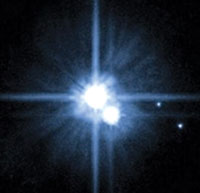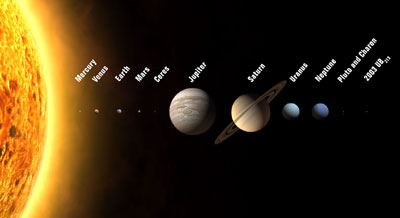 The last decade has been exciting for planetary astronomy, in large part because there are powerful new telescopes positioned on the ground and in space. For thousands of years, very little was known about the planets, other than that they were objects which moved in the sky against a background of fixed stars. The very word 'planet' comes from the Greek word for 'wanderer'.
The last decade has been exciting for planetary astronomy, in large part because there are powerful new telescopes positioned on the ground and in space. For thousands of years, very little was known about the planets, other than that they were objects which moved in the sky against a background of fixed stars. The very word 'planet' comes from the Greek word for 'wanderer'.
But today, hosts of newly discovered large objects in the outer regions of our solar system are presenting a challenge to our historical definition of a planet.
The International Astronomical Union, at its conference in Prague in August, decided that Pluto is no longer a planet, downsizing the solar system from nine planets to eight. When Pluto was discovered in 1930, there were controversies about whether it should be considered a planet or an asteroid captured by the Sun.
Pluto hasn't changed now, but the definition of a planet has, after rigorous debate among astronomers. A planet is now 'a celestial body that is in orbit around the Sun, and has sufficient mass for its self-gravity to overcome rigid body forces so that it assumes a nearly round shape, and has cleared the neighbourhood around its orbit.'
Much-maligned Pluto is automatically disqualified under the new criteria because its oblong orbit overlaps with that of the eighth planet, Neptune. Instead, Pluto along with Xena (2003 UB 313) and Ceres (an 'asteroid' between Mars and Jupiter) will be reclassified in a new category of 'dwarf planets', similar to what have long been termed 'minor planets'. These are a third class of lesser objects that orbit the Sun, 'small solar system bodies', a term that will apply to asteroids, comets, and other natural satellites. School and college textbooks around the world will have to be changed.
Interesting celestial events for September are a partial eclipse of the Moon and an annular eclipse of the Sun. During the Full Moon on Thursday, 7 September, the Moon will be almost exactly in line with the Sun and Earth, so there will be a partial eclipse of the Moon. The eclipse will start at 22:27 and will end at 02:45 AM. The maximum eclipse will be at half past midnight (00:36 AM). During the 22 September New Moon, the Sun, Earth and Moon will again be in a perfect straight line causing an annular eclipse of the Sun. This particular eclipse is NOT visible from Asia.
Other highlights in September:
The Sun is in the constellation of Leo at the start of September, moving into Virgo on the 16th. The Autumn Equinox occurs on Saturday, 23 September, when the Sun crosses the celestial equator, making the day equal to the night.
Mercury goes through a superior conjunction on 1 September to become an evening object. We won't be able to see this elusive little planet this month.

Venus is still playing the role of Morning Star, but it's getting harder to see. At the start of September, Venus rises in the east an hour-and-a-half before the Sun.
Mars sets only a few minutes after sunset, so we won't be able to see the Red Planet this month or indeed probably for the rest of this year.
Jupiter in Libra, is the only planet we can hope to see in the evening sky this month. It's low in the southwest at sunset, and sets about two hours after the Sun.
Saturn is coming up in the east in the early hours of the morning, and should be visible in the east before dawn. If you can recognise the Twin Stars of Gemini, high in the east, look for Saturn well below them.


